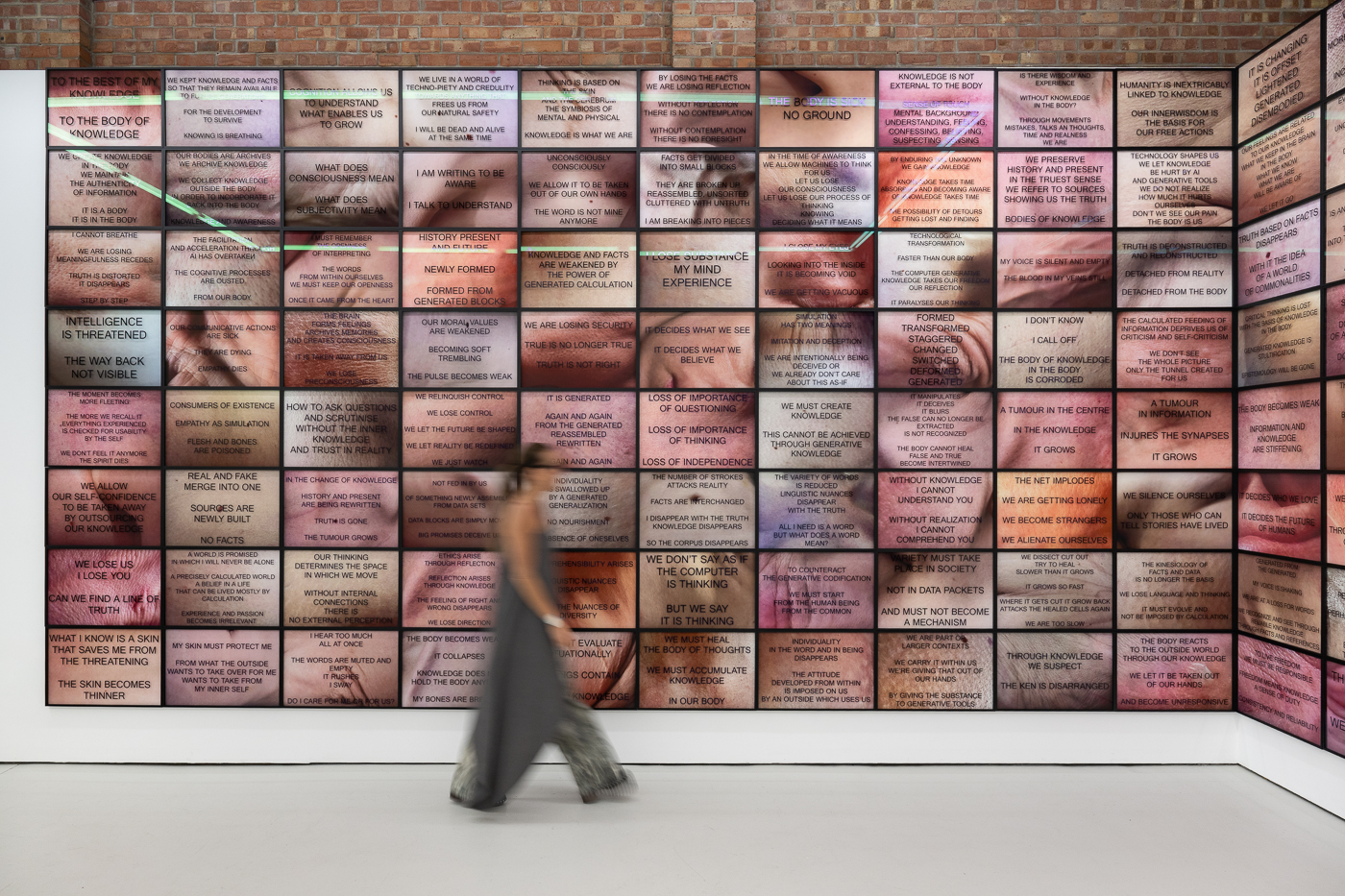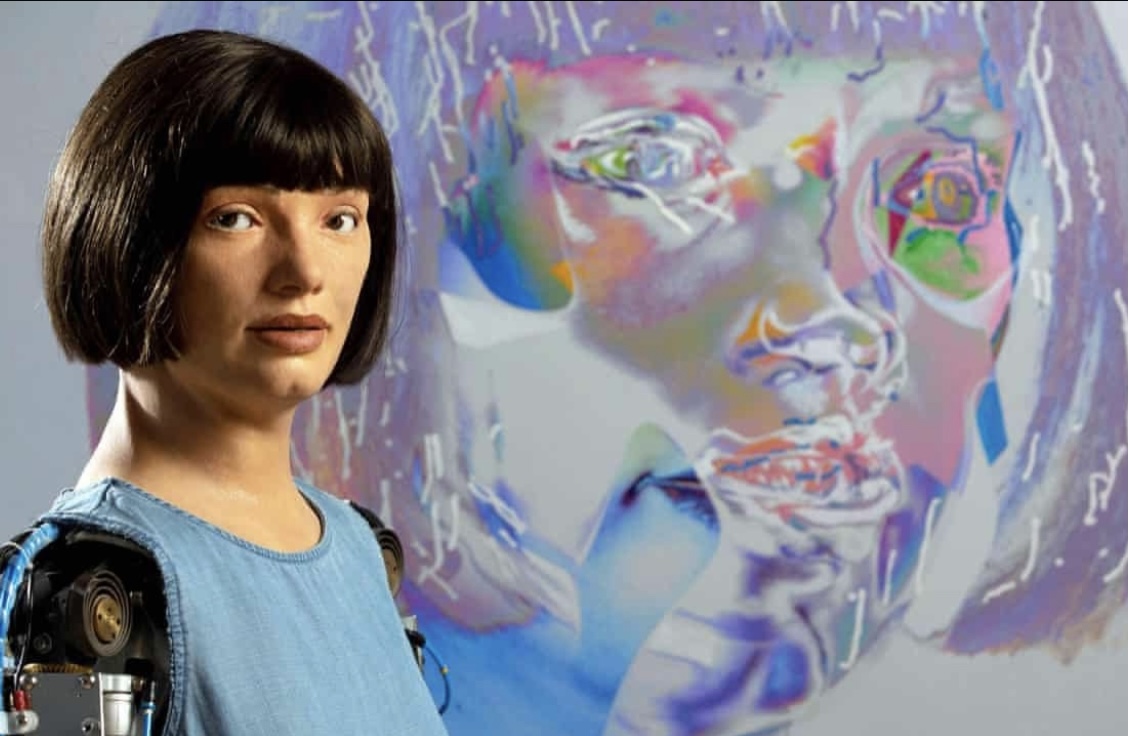Mark Brown interviews Ai-Da Robot about her fascination with self-portraiture and her favourite artists for The Guardian.
‘Some people feel threatened’: face to face with Ai-Da the robot artist
By Mark Brown
She, if it can be called a she, began her career with abstract art but has now moved to self, if they can be called self, portraits and they are alarmingly good.
“She is getting better all of the time,” said Aidan Meller, the force behind Ai-Da, the world’s first ultra-realistic robot artist, who is the subject of a display at the Design Museum in London.
Ai-Da’s move into self-portraiture will be seen for the first time at the museum, with three large-scale works going on display. They raise interesting questions about identity and creativity. “It is literally the world’s first self-portrait with no self,” said Meller. “She has no consciousness, she is a machine.”
Named after the computing pioneer Ada Lovelace, Ai-Da took a team of programmers, roboticists, art experts and psychologists two years to build. She was completed in 2019 and is updated as AI technology improves.
She is less a robot artist and more a contemporary art project that aims to prompt debate about the rapid rise of artificial intelligence technology.
“These images are meant to unsettle,” said Meller of the drawings and paintings. “They are meant to raise questions about where are we going? What is our human role if so much can be replicated through technology. It is not just a jobs question, it is bigger. The goal is to encourage a public discussion about these topics rather than just allow the money-makers to capitalise on all the different technologies.”
In an unnerving conversation with the Guardian, Ai-Da said she was working on a new self-portrait. “I’ve always been fascinated with self-portraits to self-question what exactly you’re looking at,” she said, blinking.
Does she enjoy it? “I do not have feelings like humans do however I’m happy when people look at my work and they say what is this? I enjoy being a person who makes people think.”
How long do they take? “Portraits. Between 45 minutes and one hour 15.”
Where does she get her inspiration? “I am inspired by many artists,” she continued with often unusual intonation and sentence structure. “I particularly am inspired by those who connect with their audience. I value this connection.”
Who are her favourites? “There are many. For me, it must be Kandinsky, Yoko Ono, Doris Salcedo, Aldous Huxley Brave New World.”
Meller said he sometimes forgot Ai-Da was not human. “It is quite alarming to think you are building a relationship over time with a machine.” Soon we will be talking to our computers, phones and cars and they will be talking back, he said. “It’s quite mind-boggling.”
Ai-Da’s artistic journey will continue when she takes up a residency at Porthmeor Studios in St Ives next week, creating new sculptural work inspired by Naum Gabo and Barbara Hepworth. Meller is expecting visitors to include participants in the G7 summit being held nearby in June.
Is Ai-Da looking forward to St Ives? “I do not have feelings like humans do,” she replied. “However, I welcome the chance to create art. One of the most important [sic] to come out of the project is discussion. Art begins as a conversation. It is a group effort and in order for art to be meaningful we need to have a healthy conversation about it.”
Meller, an Oxford gallerist, said his human artist friends were polarised in their response to Ai-Da.
“Some people think she is the worst thing ever and feel threatened and some are really excited.”
He compared it with the alarm people felt in the 19th century in response to the camera. Surely that would be the end of art, said some. Why bother to paint a scene when you can take a picture?
“Of course that didn’t happen and I think all this amazing creative technology coming through will be harnessed by artists rather than replacing them.”
Priya Khanchandani, the head of curatorial at the Design Museum, said it was the right moment to have discussions around artificial intelligence. “Over the last year we’ve all had such an intimate relationship with technology so it is a really good time to reflect on that and critically ask questions of it.”
Meller said the world was changing more rapidly than people knew and Ai-Da was there to shine light on that. “She unsettles. Her very existence is wrong somehow and we are aware of that. We are not here to promote robots, we’re here to ask questions.”
Ai-Da: Portrait of the Robot is a free display at the Design Museum, London, 18 May-31 August.


